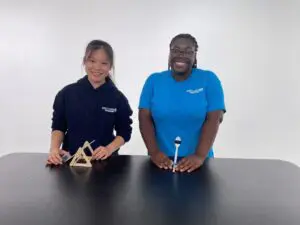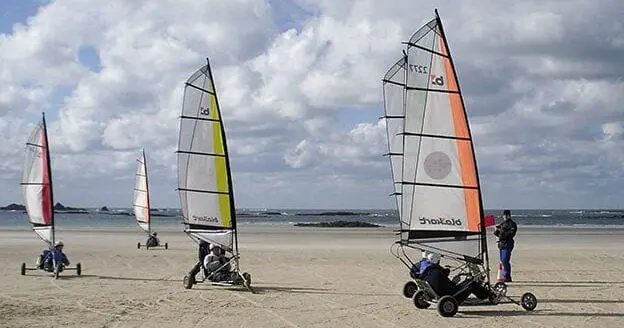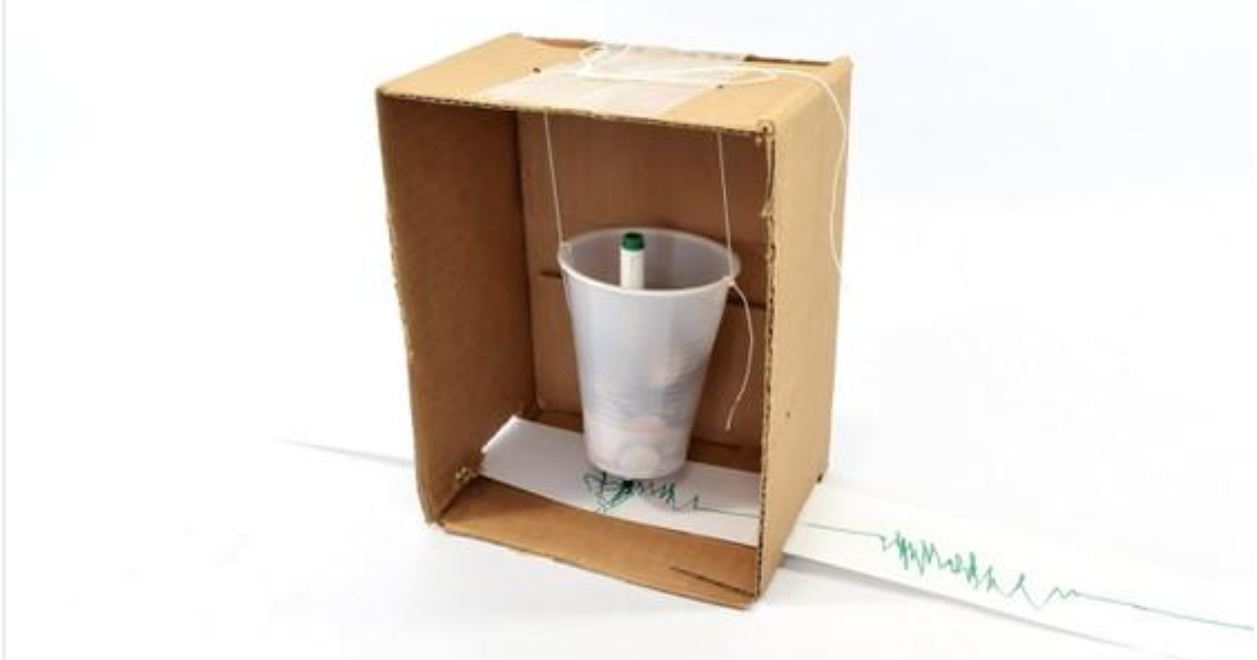Activity Content Sections
Per student or pair:
- Cardboard box to house their game (offer various sizes; must be at least 12 inches in length)
- Container to hold the object to be launched (small cups, plastic spoons, etc.)
- Objects to launch (ping-pong balls, small beanbags, cotton balls, etc.)
- Timer (can be shared by several students)
Additionally, provide a variety of building materials for students to explore. Some possibilities include:
- Cardboard tubes
- Craft sticks
- Disposable cups
- Glue
- Markers
- Paper (white, construction, cardstock)
- Rubber bands
- String or yarn
- Tape
Design an arcade game that uses a catapult to launch an object and hit a target.
Background
Mechanical engineers design machines that involve force, energy, motion, and power. In 400 BCE, engineers in Greece designed a machine to launch arrows and stones during warfare—the catapult. A catapult is a type of lever that consists of three essential parts: a stable base, a launching arm, and a source of tension. When the arm of the catapult is pulled backwards, the tension and potential energy increase. When the arm is released, the potential energy turns into kinetic energy and is transferred to the object being launched. It’s the kinetic energy that propels the object toward its target.

Image by jackmac34 from Pixabay
Did you know that your body has a built-in catapult that you use every day? Consider what happens when you throw a ball. When you bring your arm back, tension builds in the muscles, tendons, and ligaments that cross your shoulder. Hinged at the elbow, your forearm snaps forward to launch the ball.
How to Use This Activity
- Review these Leader Notes. Then decide how to group students to complete the activity. This challenge is great fun for students working in pairs, if possible. They can collaborate, discuss their design, and enjoy testing together.
- Watch the Score! Challenge Video showing students Miranda and Star doing the activity. Think about how you will use it. You can show the whole 6-minute video to help spark ideas, or show the introduction, pause the video to do the activity, and watch the rest after the activity.
- Make copies of the Student Instructions so that each student has their own copy to reference during the whole-group activity.
- Gather the materials and decide how you’ll distribute them. Consider setting up a materials table in an accessible area of the room where students can take what they need.
- Find photos on the Internet of nonelectronic arcade games that require skill to throw an object at a target. Some examples include Skee-Ball, cornhole, Down the Clown, or a basketball-shooting game.
Success Criteria
The arcade game must:
- include at least one target
- launch an object toward the target(s) using a catapult
- include point values for hitting the target(s)
Engineering Constraints
- The catapult must be able to launch objects repeatedly during a two-minute “round.”
- The launched object must travel a distance of at least 12 inches.
Instructions
Introduce the Challenge
- Activate students’ prior knowledge by showing a few photos of throwing games and asking questions about nonelectronic games they might find in an arcade or at a party.
- Have you ever played Skee-Ball at an arcade? How do you play? What is the goal?
- Who has played cornhole? Explain the rules of the game and the goal.
- Can anyone think of other nonelectronic games that require the player to launch or throw an object to earn points?
- Point out that in the above examples, the player throws or rolls the object using their own hands. However, in today’s activity, they will design an arcade game that uses a catapult, or launcher, to hit a target. Explain how that might look in the arcade examples that were discussed (e.g., instead of rolling a ball down a track in Skee-Ball, the player would aim and use a launcher to try to sink the ball into the center or another high-point target).
- Explain some of the science concepts behind the catapult:
- Transfer of energy—tell students that when the arm of a catapult is pulled backwards, the tension creates potential energy, or the energy that is stored in the arm because of its position. When the arm is released, the potential energy becomes kinetic energy and is transferred to the object, which sends it flying through the air. Kinetic energy is the energy the object has while it’s in motion.
- Exploration of angles— tell students that the angle at which the object is released affects how far the object is thrown. Using your arm as an example, pivot at the elbow and show that releasing a ball at a 45-degree angle launches the ball forward and upward in an arc that travels the farthest distance. In contrast, show how a greater angle pops the ball higher into the air, but it travels a shorter distance. Finally, show that a lesser angle produces the smallest arc and pushes the ball toward the ground. Encourage students to experiment with the angle of release as they build their games.
- Show the Challenge Video, present the design challenge, and define the success criteria and engineering constraints.
Brainstorm Solutions
- Introduce the materials that students can use to build their arcade games. Tell students that their game needs to be housed within a cardboard box; however, it can extend upward into the space directly above the box.
- Have students work in pairs to brainstorm and sketch their game designs. Encourage them to consider the number of targets their game will include and whether their launcher will need to move or swivel to align with the targets.
- Remind students of the design constraints and success criteria, if needed.
Build, Test, Redesign
- Give students time to experiment with different materials and build. As they work, circulate and provide support. To encourage students to think more deeply about the challenge, ask guiding questions such as:
- How does your arcade game work?
- How many targets does it include? Which targets are easiest to hit? Which are hardest? Why?
- How does the launcher work? How will the player align the launcher with the targets? Does the launcher need to move? If so, how will that work?
- What object will players launch? Do some objects work better with your catapult than others? Why?
- Encourage students to test as they build and redesign as needed. They will need to constantly assess whether their arcade game is functioning as planned. If it’s not, they will need to make adjustments, or they might need to change their design entirely.
- Remind students to test their games in two-minute rounds. They’ll need to consider how many launchable items to include with their game and how to quickly ready their catapult for successive launches.
- As students build, have them think of a creative name for their arcade game. They can decorate a sign and attach it to the exterior of their game.
Addressing Frustration
If students get frustrated with their design or need to start over, explain that things don’t always work as planned. Setbacks are a natural part of the design process! Here are some tips to help students persevere:
- Encourage them to talk through their design. Help them figure out what’s not working and brainstorm new ideas to try.
- Break down large tasks into smaller, more manageable chunks. This can be helpful if students feel overwhelmed or don’t know how to move forward.
- Suggest that they take a break and come back to it in a few minutes. They can talk with classmates to get inspiration or help testing their designs.
- Compliment them on the hard work they’ve done so far!
Reflect
- Bring students together to discuss and share. Ask questions such as:
- What could you add to your arcade game to make it more fun or challenging?
- What did you think of the challenge?
- Which parts of your arcade game were easy to build? Which parts were harder to build?
- What were some of the problems that you faced? How did you solve them?
- Who would like to demonstrate how their arcade game works? (Encourage students to use scientific concepts in their explanation, such as potential and kinetic energy.)
- Read the success criteria aloud and have students raise their hands if they met them.
- Provide time for students to play each other’s games and keep score! If students named their arcade games, create a leader board where students can record their high scores.
STEM Connections
Engineering & Science Connections
Even though catapult technology is almost 2,500 years old, it is still being developed and used today. In the early 1900s, the United States military wanted to send aircraft into battlefields around the world, which meant designing a way to carry a fleet of them across vast oceans. The solution—large aircraft carriers that function as portable airports. Modern aircraft carriers can carry up to 80 aircraft, over 6,000 people, and enough supplies to last for months at sea. However, despite their enormous size, the flight decks on the carriers are about the length of a football field, which is much too short for aircraft to gain enough speed to take off on their own. To take off aboard a carrier, they require an additional power source such as a catapult.
It wasn’t until the 1950s that mechanical, electrical, and aerospace engineers developed the steam-powered catapult. These catapults use highly pressurized steam to supply extra power, enabling the aircraft to speed down the runway and launch. Steam-powered catapults were used exclusively until 2017, when the electromagnetic catapult was invented. The electromagnetic catapult can be used to launch bigger, heavier aircraft from the flight deck. It also takes less energy and can be ready to launch in 15 minutes, compared to the hours-long process to create steam. Both types of catapults continue to be used, although the electromagnetic catapult has been criticized for its higher failure rate.

Photo by Pixabay
Extensions
- Scale it up! Have students work in groups of four to create an outdoor game that spans a greater distance (i.e., 10 to 15 feet). They can set up their games in a field or on a blacktop. Organize a field day and invite other classes to join the fun!
- Challenge student pairs to create a cotton-ball launcher and hold a competition to see which machine launches the cotton ball farthest. Record each pair’s best attempt.
NGSS Standards
Grades 3–5
4-PS3-3 Ask questions and predict outcomes about the changes in energy that occur when objects collide.
4-PS3-4 Apply scientific ideas to design, test, and refine a device that converts energy from one form to another.
3–5ETS1-1 Define a simple design problem reflecting a need or a want that includes specified criteria for success and constraints on materials, time, or cost.
3–5ETS1-2 Generate and compare multiple possible solutions to a problem based on how well each is likely to meet the criteria and constraints of the problem.
3–5ETS1-3 Plan and carry out fair tests in which variables are controlled, and failure points are considered to identify aspects of a model or prototype that can be improved.
Grades 6–8
MS-PS3-2 Develop a model to describe that when the arrangement of objects interacting at a distance changes, different amounts of potential energy are stored in the system.
MS-ETS1-1 Define the criteria and constraints of a design problem with sufficient precision to ensure a successful solution, taking into account relevant scientific principles and potential impacts on people and the natural environment that may limit possible solutions.
MS-ETS1-4 Develop a model to generate data for iterative testing and modification of a proposed object, tool, or process such that an optimal design can be achieved.






Leave feedback form
Thank you! Your submission is processing.